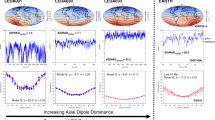Summary
It has been predicted that the geomagnetic field strength will be at its highest during periods of low reversal frequency. Using basaltic lavas from Israel and India, which were erupted during the 35 Ma interval of normal polarity in the mid-Cretaceous (the Cretaceous Quiet Zone), we have obtained palaeointensity estimates. The mean virtual dipole moments from the two areas are about 75% of the present value. This suggests that there is no simple relationship between the time averaged strength of the dipole and the frequency of reversals.
Similar content being viewed by others
References
W. B. Harland, V. A. Cox, P. G. Llewellyn, C. A. G. Picton, A. G. Smith, R. Walters: A geologic time scale. Cambridge University Press, Cambridge 1982.
P. L. McFadden, M. W. McElhinny: Variations in the geomagnetic dynamo 2: statistical analysis of VDM's for the last 5 million years. J. Geomag. Geoelectr., 34 (1982), 163.
D. Gubbins: A mechanism for geomagnetic reversals (abstract). Geophys. J. R. Astron. Soc., 89 (1987), 470.
P. Pal, P. H. Roberts: Long-term polarity stability and strength of the geomagnetic dipole. Nature, 331 (1988), 702.
P. Pal: The correlation of long-term trends in the palaeointensity and reversal frequency variations. J. Geomag. Geoelectr., 43 (1991), 409.
J. Briden: Variation of the intensity of the palaeomagnetic field through geological time. Nature, 212 (1966), 246.
E. J. Schwarz, D. T. A. Symons: On the intensity of the paleomagnetic field between 100 million and 2500 million years ago. Phys. Earth. Planet. Inter., 1 (1968), 122.
C. M. Carmichael: An outline of the intensity of the palaeomagnetic field of the Earth. Earth Planet. Sci. Lett., 3 (1967), 351.
N. Roberts, J. Shaw: The relationship between the magnitude and direction of the geomagnetic field during the Late Tertiary in eastern Iceland. Geophys. J. R. Astron. Soc., 76 (1984), 637.
G. J. Sherwood, J. Shaw: Palaeointensity determinations on the Miocene of New Zealand. J. Geomag. Geoelectr., 38 (1986), 1331.
M. Prévot, E. A. Mankinen, R. S. Coe, C. S. Grommé: The Steens Mountain (Oregon) geomagnetic polarity transition. II. Field intensity variations and discussion of reversal models. J. Geophys. Res., 90 (1985), 10 417.
J. Shaw, G. J. Sherwood, A. E. Mussett, T. C. Rolph, K. V. Subbarao, P. Sharma: The strength of the geomagnetic field at the Cretaceous-Tertiary boundary: palaeointensity results from the Deccan Traps (India) and the Disko Lavas (Greenland). J. Geomag. Geoelectr., 43 (1991), 395.
A. S. Bolshakov, G. M. Solodovnikov: Intensity of the geomagnetic field in the last 400 million years. Doklady Akad. Nauk SSSR, 260 (1981), 1340.
A. S. Bolshakov, G. M. Solodovnikov: Geomagnetic field intensity in Armenia in the late Jurassic and early Cretaceous. Izv. Earth Phys., 19 (1983), 976.
A. S. Bolshakov, G. M. Solodovnikov, Y. K. Vinogradov: Paleointensity of the geomagnetic field in the Early and Middle Jurassic. Izv. Earth Phys., 23 (1987), 324.
C. Radhakrishnamurty, S. D. Likhite, P. W. Sahasrabudhe: Nature of magnetic grains and their effect on the remanent magnetization of basalts. Phys. Earth. Planet Inter., 13 (1977), 289.
W. E. Senanayake: Geomagnetic field in the geological past. Unpubl. PhD thesis, Australian National University, Canberra 1981.
C. Radhakrishnamurty, S. D. Likhite, P. W. Sahasrabudhe: Domain states of magnetic grains in basalts in palaeointensity techniques. J. Geomag. Geoelectr., 43 (1991), 351.
A. K. Baksi: 40Ar-39Ar incremental heating study of whole-rock samples from the Rajmahal and Bengal Traps, eastern India. Terra Cognita, 6 (1986), 161.
G. J. Sherwood: Some rock magnetic properties of mid-Cretaceous basalts from Israel and India (Rajmahal Traps), and their bearing on palaeointensity experiments. Phys. Earth Planet. Inter. (in press).
J. A. Shaw: A new method of determining the magnitude of the palaeomagnetic field: application to five historic lavas and five archaeological samples. Geophys. J. R. Astron. Soc., 39 (1974), 133.
T. C. Rolph, J. A. Shaw: A new method of palaeofield magnitude correction for thermally altered samples and its application to Lower Carboniferous lavas. Geophys. J. R. Astron. Soc., 80 (1985), 773.
M. Prévot, M. E. Derder, M. McWilliams, J. Thompson: Intensity of the Earth's magnetic field: evidence for a Mesozoic dipole low. Earth Planet. Sci. Lett., 97 (1990), 129.
V. Courtillot, J. Besse: Magnetic field reversals, polar wander, and core-mantle coupling. Science, 237 (1987), 1140.
Author information
Authors and Affiliations
Rights and permissions
About this article
Cite this article
Sherwood, G.J., Shaw, J. The relationship between magnetic field strength and reversal frequency: Preliminary palaeointensity results from the cretaceous quiet zone. Stud Geophys Geod 35, 325–333 (1991). https://doi.org/10.1007/BF01613978
Received:
Published:
Issue Date:
DOI: https://doi.org/10.1007/BF01613978




